OUR SOLUTION N°4 : DOMINO SURGERIES
A CASCADE OF PRE-IMPLANT SURGERIES
TO MAKE THE IMPOSSIBLE PLACEMENT OF IMPLANTS IN MCI POSSIBLE
REBUILD YOUR ENTIRE JAW AND SMILE
THE DOMINO EFFECT OF RECONSTRUCTION SURGERIES
CASCADE SURGERIES - UNDER GENERAL ANESTHESIA
THE SMILE DESIGNER SOLUTION N°4: THE "DOMINO SURGERIES
OUR JOKER TO MAKE IMPOSSIBLE CASES OF IMPLANTOLOGY POSSIBLE
CASCADE SURGERIES TO RETURN TO RESTITUTIO AD INTEGRUM
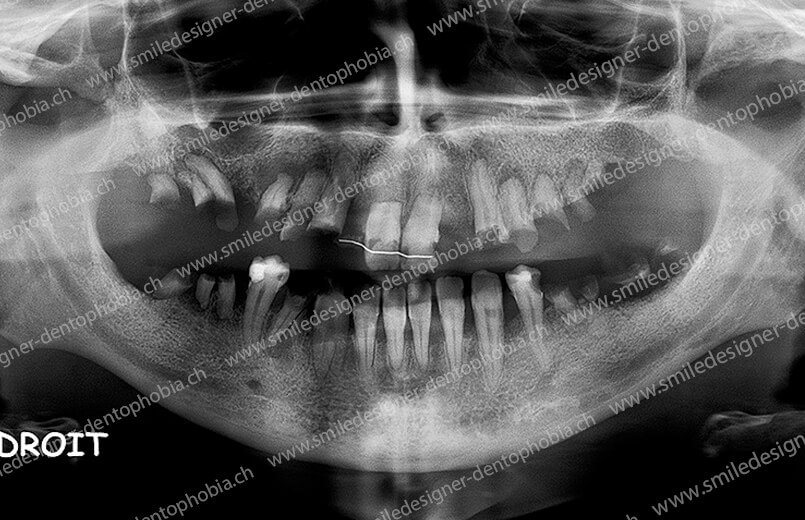
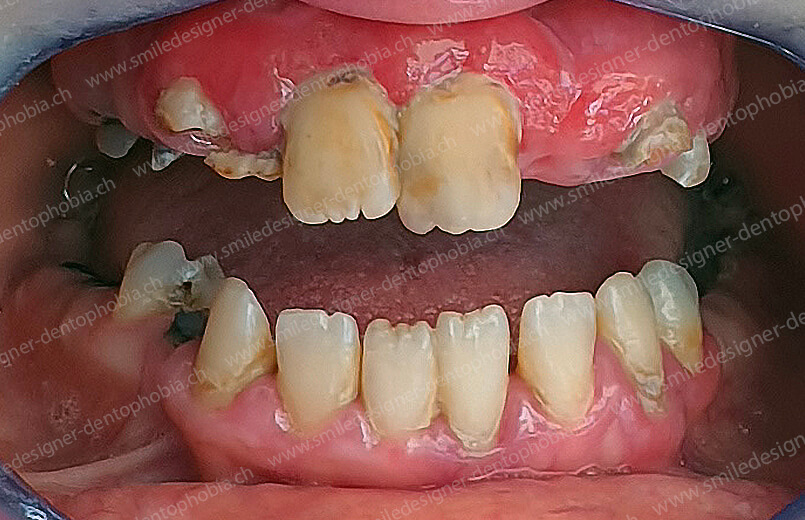
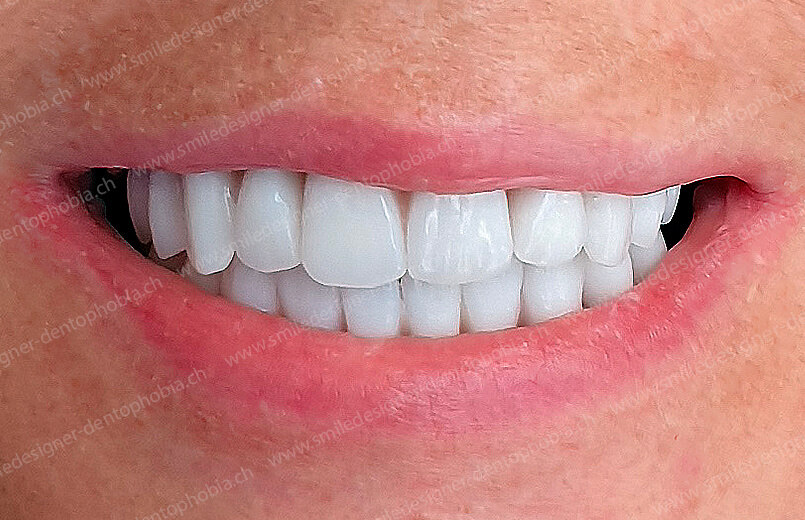
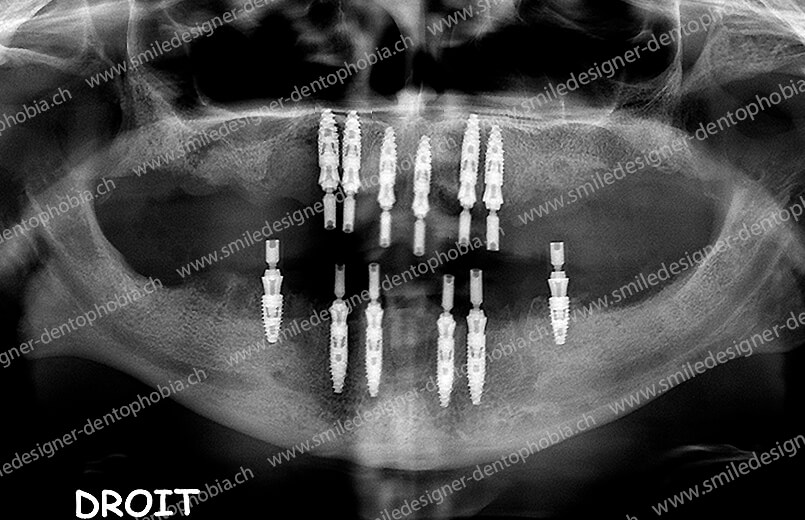

"THEIR STORY IS THE DOMINO THEORY, BUT IN REVERSE. INSTEAD OF MAKING EACH OTHER FALL, THEY HELP EACH OTHER TO GET UP AGAIN".
ANNA GALVADA
OUR EXTREME SMILE RESCUE PROTOCOL: THE "DOMINO SURGERIES
TWO IMPLANTOPORTED "ALL ON 6/6" EMERGENCY BRIDGES WITH MINIMUM EXTENSIONS
THE PREIMPLANT BONE GRAFTING CASCADE ANTI CONTRAINDICATIONS MCI
THE ESSENTIAL PREREQUISITE FOR MAKING SMILE RECONSTRUCTION POSSIBLE
OUR NUMBER FOUR SOLUTION: "DOMINO SURGERIES MCI
This is an immediate implant placement protocol for EXTREME rescue of your smile and posterior mastication.
The entire “Domino surgeries” protocol is spread over several months, with a succession of pre-implant interventions by bone grafts. Hence the name “domino effect surgeries”.
When the case allows it, a is performed at the beginning of the surgical cascade to provide a quick solution to the problem of the disfigured smile.
The indication for the sequence of bone grafts is determined by the amount of alveolar bone resorption in the premolar and molar areas. molar sectors.
This protocol for saving your smile, thanks to the placement of implants as soon as possible (if the indication is given according to the clinical case) is carried out according to the following surgical scheme:
– The placement of 6 implants, as an emergency replacement of the upper anterior teeth, from the canines or first premolars on the right to the canines or first premolars on the left, in order to in order to treat the problem of the smile;
– The placement of 6 implants in the mandible is usually sufficient to reconstruct the dental arch. In cases of extreme resorption of the alveolar bone ridge, a minimal version of four implants is adopted;
– The fixation a few days later, thanks to an Immediate Loading of the dental implants, of an implant-supported aesthetic bridge WITH two extensions at the posterior ends, to replace the first premolars or at best the second premolars.
In a case of bimaxillary surgery, the replacement of the anterior and posterior teeth of the mandible is achieved by an Immediate Loading of 6 dental implants with two screw-retained implant bridges.
Bone resorption problems in the posterior regions are usually most severe in the maxilla.
In the maxilla (but also in the mandible) the supra-implant prosthesis in MCI is supported by implants from the right canine/premolar to the left canine/premolar WITH two posterior extensions at the premolar level.
The addition of premolar extensions at the ends of the bridge allows for minimal premolar wedging, even if these teeth are not supported by implant abutments.
This is our “most extreme life-saving solution in desperate clinical situations”.
These serious clinical situations present numerous contraindications to the placement of dental implants, particularly in immediate loading.
“Domino Surgeries is the most complex of our protocols, but also the most powerful in terms of dental reconstruction.
First, it allows you to save your smile by placing implants in the front part of the jawbone, i.e. the teeth of the smile.
Secondly, thanks to a series of surgical interventions to reconstruct the alveolar bone ridges of the jawbone, most of the contraindications to the placement of posterior implants can be removed, in order to save your posterior mastication.
In this configuration, it will be necessary to perform a series of pre-implant bone grafts scheduled over several months.
“Domino Surgeries” is indicated in case of severe decay of your teeth and smile and with very high alveolar bone resorption.
- The biggest advantage of our “Domino Surgeries” solution is the immediate and almost identical global reconstruction of the anterior aesthetics of the dental arches, in the presence of a desperate situation that requires the rapid extraction of all the residual teeth, without having to perform pre-implant bone grafts for the reconstruction of the jaws, even if the posterior bone resorption is very significant. However, this is only possible in the most favorable cases.
- The surgeon and the patient are exempt from performing complex pre-implant surgeries, such as sinus lift. However, this is only possible in the most favorable cases.
- The cost of the FIRST PHASE OF RECONSTRUCTION remains moderate. It is identical to an implant-supported full ceramic bridge in immediate loading, but only in the most favorable cases.
- It immediately restores a beautiful aesthetic to the teeth of the smile, for demanding patients. But only with a temporary resilient bridge, for a short-term horizon of a few months. It will be replaced by a permanent bridge with a ceramic cosmetic, while all the complementary interventions of reconstruction of the bone bases are carried out.
- Despite the low number of implants, its high mechanical strength makes it suitable for the average person: from the elderly to active people and for all types of food. But only if you have a soft diet and take precautions. The horizon is short term, the time to make all the complementary interventions.
- The postoperative resilient implant-supported bridge restores minimal aesthetic and masticatory function, but no articular wedging of the TMJs, which can generate joint pain.
- The major disadvantage is that the prosthetic arch is not very extended posteriorly, in the masticatory premolar and molar regions: the occlusal load is thus shifted towards the front teeth. This can cause problems with the mechanical strength of the bridge and/or implants.
- Even if it restores a beautiful aesthetic to the teeth of the smile, it is only with the postoperative version of the resilient implant-supported bridge and, therefore, for a short-term horizon, the time to go on with the other complementary interventions.
- Even if the cost of the FIRST PHASE OF RECONSTRUCTION remains moderate. (It is identical to a full ceramic implant-supported bridge in immediate loading, which would require bone grafts and/or sinus fillers). The fees for the entire protocol (consisting of the cascade of pre-implant jaw reconstruction procedures) add up to a large total.
- Although it restores aesthetic appeal to the teeth of the smile, it is only a temporary anterior reconstruction for the short term. The objective is a total reconstruction of the dental arch and the realization of a molar to molar bridge.
- The mechanical disadvantages and the risk of fracture of metal implant parts (e.g. screws, implants, frameworks) in the historical version of the All on 6/4, linked to the relatively small number of dental implants (four in the mandible and six in the maxilla) that support a number of extended prosthetic teeth, are once again relevant. It is important to quickly reconstruct the posterior sectors.
- The problem of the historical “All on 6/4” version with a bridge supported by dental implants concentrated in the anterior area of the maxilla, upper and lower, creating an overhang due to the anteroposterior tilt, is again relevant. It is important to quickly reconstruct the posterior sectors.
- Its relatively low mechanical strength makes it suitable for small bodies, elderly people, people with little activity and for soft food types. It is important to quickly reconstruct the posterior sectors.
- This protocol is not suitable for large patients as there is an increased risk of fracture of the implant-supported bridge and/or implants. In these clinical cases, it is important to rapidly reconstruct the posterior areas.
- Even though the surgeon and the patient usually avoid complex pre-implant surgeries as a prerequisite for the first placement of implants, they are most often necessary to extend the molar occlusion posteriorly. This is the principle of the cascade surgeries that are described in our “DOMINO SURGERIES MCI” protocol.
- Even if premolar extensions restore minimal masticatory function, they are most often insufficient and the articular wedging of the TMJs is ineffective. The protocol is only completed when the first molars are replaced. Below this limit, cascade surgeries described in our protocol “DOMINO SURGERIES MCI” will be necessary to achieve this goal.
- If the surgeon and the patient avoid complex pre-implant surgeries, such as sinus lift, the premolar extensions of the first intentions restore only a minimal masticatory function and no valid articular wedging of the TMJ.
- If the molar wedge is absent, temporomandibular joint (TMJ) pathologies may occur in the medium or long term. For example, pain or cracking and/or inter-articular meniscus mobility may be felt and/or tinnitus.
- The molar wedging of the posterior extensions of the bridge, even at a minimum, protects the temporomandibular joints and prevents various pathologies such as joint pain, vertigo, tinnitus, etc.
- the absence of teeth in the posterior area leads to poor chewing, a feeling of “empty mouth” and food blockages at the ends in extensions of the implant-supported bridge.
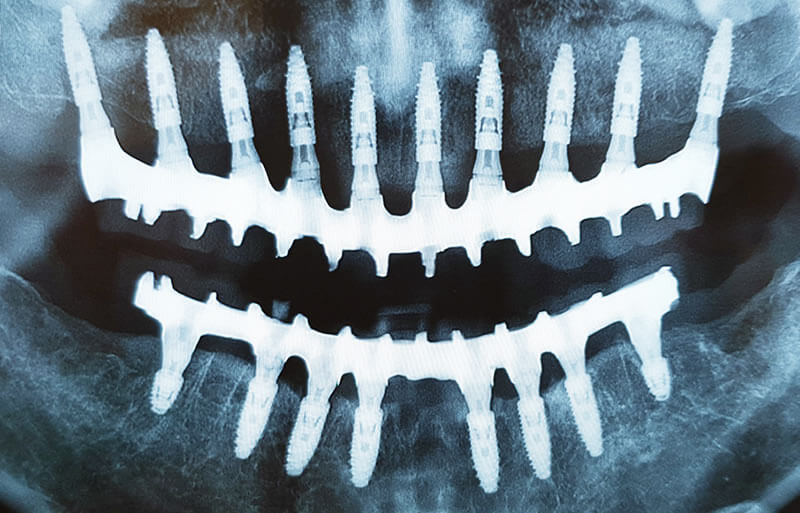
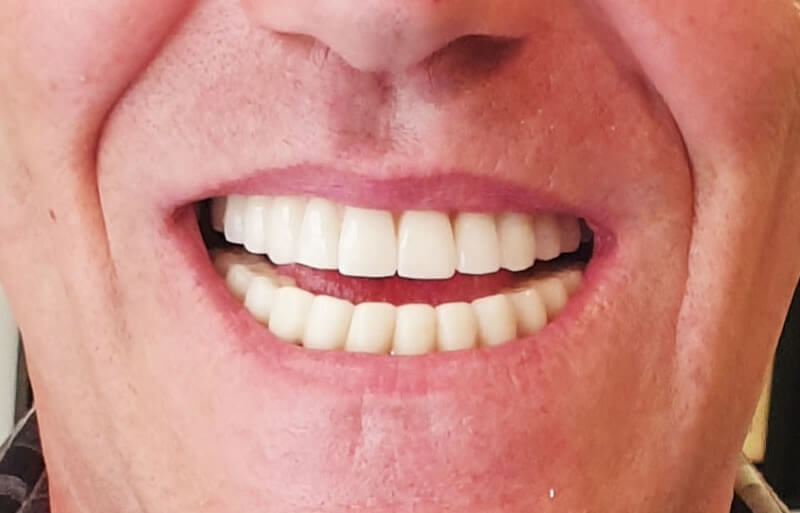
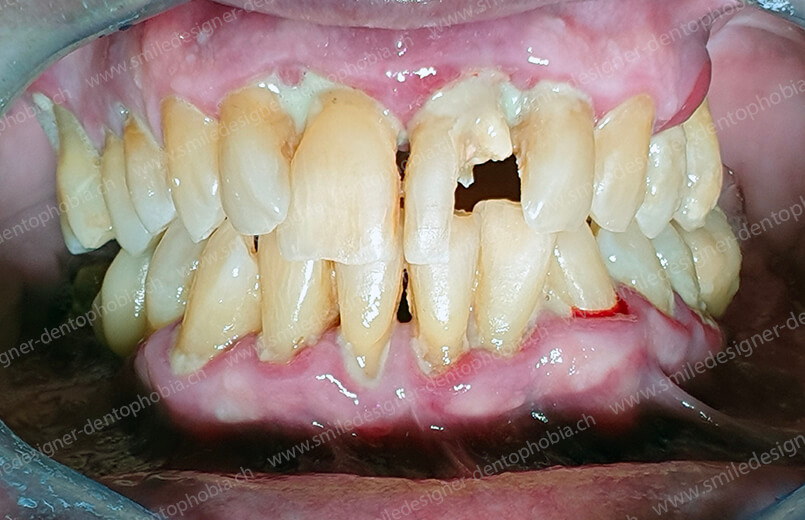
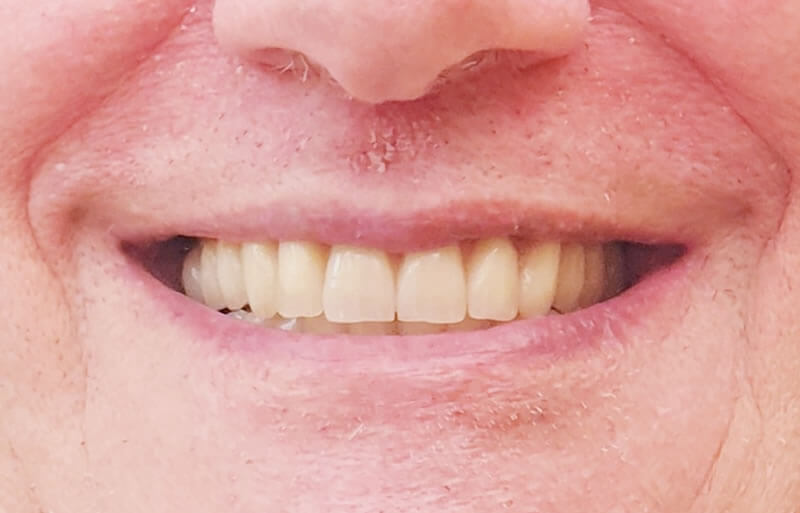
Our clinical result: you have your brand new smile in one implant placement procedure with the delivery of your implant-supported bridges in just a few days.
Domino Surgeries: Our protocol for emergency placement of implants from first premolar to first premolar or “All on 6” in the maxilla and “All on 6/4” in the mandible and the realization of two implant-supported full bridges in a minimal salvage version from first premolar to first premolar, with extensions to replace the first and/or second premolars
Disclaimer: Even though we show satisfactory clinical results in our presentation photos, they can in no way be promises of similar success in your own clinical situation. Each person is different and each clinical case is unique.
YOU ARE UNIQUE!
CLINICAL CASES OF SMILE RECONSTRUCTION WITH OUR SOLUTION 4 "DOMINO SURGERIES" IN MCI
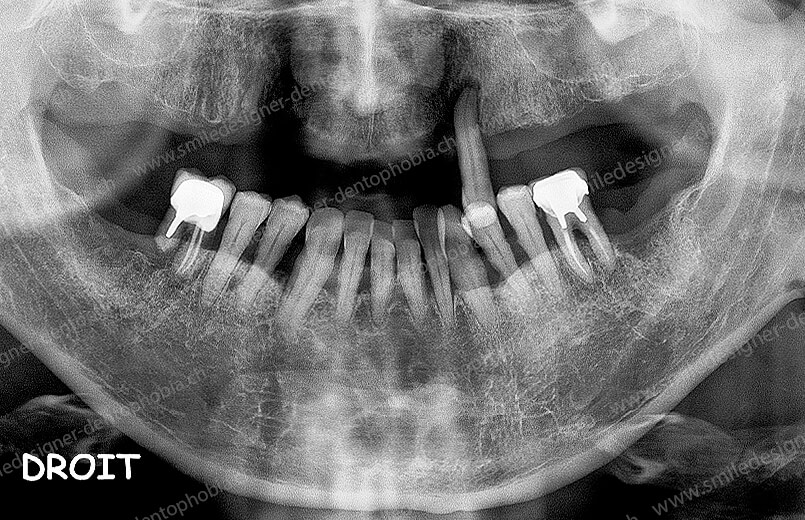

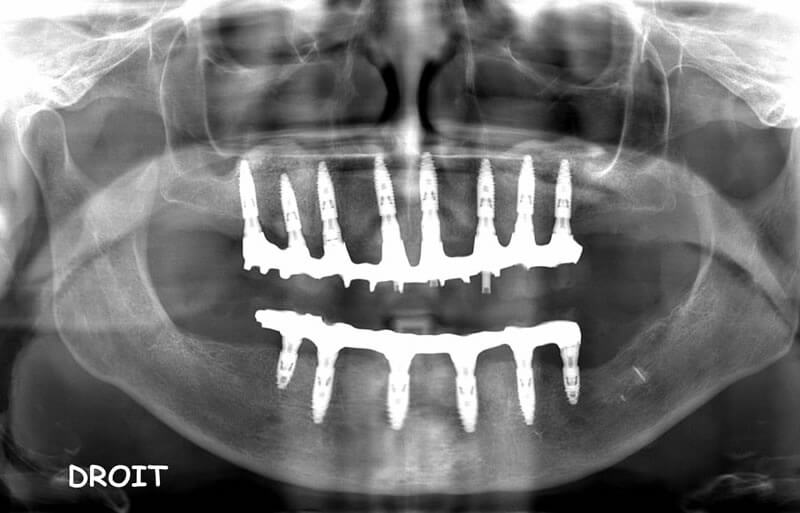
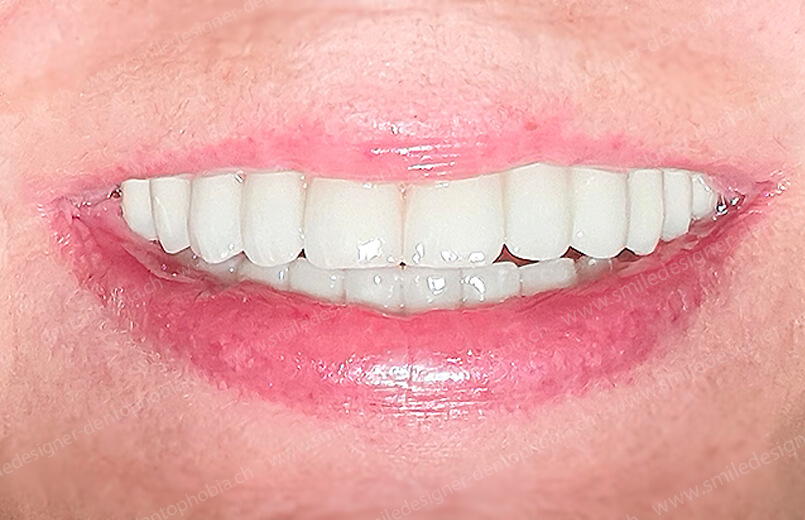
Our clinical result: you have your brand new smile in one implant placement procedure with the delivery of your implant-supported bridges in just a few days.
Domino Surgeries: Our protocol for emergency placement of implants from first premolar to first premolar or “All on 6” in the maxilla and “All on 6/4” in the mandible and the realization of two implant-supported full bridges in a minimal salvage version from first premolar to first premolar, with extensions to replace the first and/or second premolars
Disclaimer: Even though we show satisfactory clinical results in our presentation photos, they can in no way be promises of similar success in your own clinical situation. Each person is different and each clinical case is unique.
"domino surgeries: a cascade of jaw reconstruction surgeries
At Smile Designer, we call our
e call our smile rescue solution 4 the “Domino Surgeries” in MCI.
Our protocol consists of a series of surgical interventions that are triggered in cascade, like a “domino effect”, to reconstruct the implantable maxillary bone pieces, with the objective of achieving a reconstruction of the type of our “Gold standard MCI solution 1”.
Our protocol will set up a cascade of implant surgeries. In the best of cases, it begins with a rapid resocialization of the patient thanks to the placement of six anterior implants, in immediate loading, in order to reconstruct the smile and minimal mastication.
Then a cascade of pre-implant grafts will be scheduled, to help control the damage your teeth and smile have sustained. The interventions are quickly performed one by one, or in several compacted interventions in “one shot”, i.e. in a single operating time, according to the operative indications.
But this is a long process: at each stage we must wait for the bone to heal for at least four months, before carrying out the following interventions, which fit one into the other like dominoes that are jostled together.
This first MCI implant placement procedure concerns only the anterior sector, in this clinical configuration of strong resorptions of the posterior sectors.
The implant-supported bridge in MCI therefore requires two posterior premolar extensions to complete the dental arch at a minimum. These allow a minimal dispersion of the masticatory forces, thanks to the placement of a low number of implants, but optimum taking into account the amount of bone available, despite the high bone resorption.
Our protocol
“Domino Surgeries MCI”, in its first stage of surgery,
does not allow a perfect immediate reconstruction
immediate reconstruction
of your dental arches.
But, it is a first quick and very effective solution to make you find your smile in the emergency of a desocialization, consequence of the ineluctable loss of your teeth, associated with a big posterior bone resorption of the maxillae, in particular the upper one.
You will have to wait until the end of the cascade surgical sequence to hope to recover your smile and your mastication “ad integrum”, of the “Gold Standard” type.
In the technique ” Domino Surgeries MCI “technique, we are able to place 6 implants in the maxilla, despite the resorption of the posterior bone (especially the upper bone).
That is, 3 symmetrical implants on each side of the sagittal midline: ALL on 6.
The particularity of this technique is that: the implant-supported bridge, in immediate loading on the implants placed, supports a first premolar in extension, on each side and at its posterior ends.
The clinical cases that indicate the practice of “Domino Surgeries MCI” belong to the unfavorable cases to make MCI with our solutions one, two and three:
Our number four protocol “Domino Surgeries” allows for the rescue of patients with terminal edentulism and high posterior bone resorption.
However, it is necessary to have sufficient anterior implantable bone volume to place six implants in the maxilla (three implants on the left and three on the right).
Very unfavorable clinical cases of terminal resorption can lead to the ultimate rescue solution: the placement of zygomatic implants.
The indications of the “Domino Surgeries” are as follows:
– Sufficient available anterior bone volume of the maxilla for the placement of implants in All on 6/6 or 4 in the area of the smile teeth;
– Associated with significant resorption of the posterior alveolar bone, beyond the areas of the canines, premolars and molars;
– Resorption of the alveolar bone in the premolar and molar regions prohibiting a three “Damage Control” solution and of course the two “Gold Damage Control” and one “Gold Standard” solution.
Consequently, there is always a posterior terminal tooth in extension: the first premolar.
The configuration of our ” Domino Surgeries “ is an immediate BUT partial rescue solution in edentulous situations at the extreme limit of chewing comfort. It is the placement of anterior implants in MCI in very unfavorable clinical cases, prohibiting the “Damage Control MCI” solution.
The placement of implants in ALL on 6 alone cannot be a definitive solution, because only the first premolars are replaced and the patient has no comfort of mastication, nor articular wedging.
Moreover, only a small patient can be satisfied with so few implants concentrated in the anterior region.
But, the first phase of our Domino Surgeries solution can be a comfortable waiting solution before attempting to approach our
“Gold Standard MCI
with a series of pre-implant grafts.
The first surgical phase of our solution four ” Domino Surgeries ” MCI allows an immediate reconstruction of the entire anterior arch.
Only the bite registration, which is called “molar occlusion”, is not present and only a minimal premolar registration is reconstructed. The molar occlusion allows the bite to be blocked in a backward articular position (centric relationship) and protects the temporomandibular joint or TMJ.
The first step of our ” Domino Surgeries ” solution is only an immediate rescue solution for your smile. But, at the very least, aesthetics and certainly not your chewing.
On the other hand, thanks to the cascade of jaw reconstruction procedures, the patient may find himself in a favorable situation corresponding to our first three solutions “Damage Control MCI” or “Gold Damage Control” or even if the clinical case allows it, we will be in the most favorable situation which is the goal of the “Domino Surgeries” protocol: the “Gold Standard”.
This technique allows for the emergency replacement of the anterior teeth of the maxilla:
Thanks to an Immediate Loading of 6 dental implants, by an implant-supported aesthetic bridge from right canines or first premolars to their contralateral left ones, with posterior extensions replacing :
- The first premolars at worst;
- The second premolars at best.
In the case of mandibular MCI:
The replacement of all the teeth in the lower jaw with implants is achieved by placing 6 dental implants. This situation is usually sufficient to rebuild the root system in MCI.
Only the possibility of placing only 4 anterior implants makes the situation very complex.
Their Immediate Loading is performed by an implant-supported prosthesis from right premolar to left premolar, with two posterior premolar extensions.
The addition of premolar extensions at the ends of the bridge allows premolar wedging even if these teeth are not supported by implant abutments.
the therapeutic objective is to move from "domino surgeries" to the "gold standard
The protocol “Domino Surgeries MCI corresponds to the cascade of pre-implant surgical interventions necessary to allow the placement of implants in MCI, despite an almost total destructuring of the maxillary bone bases that makes immediate loading of dental implants unfeasible, for the entire dentition of the maxillary arch.
Pre-implant bone grafts: the prerequisites for placing dental implants in the posterior sectors of the maxilla. The crucial importance of bone grafting to fill the sinus floor, called “Sinus Lift” in the “Gold Standard MCI ” protocol in the maxilla.
Some clinical implant cases are desperate. In particular, because of post-extraction bone resorption of natural teeth, which leads to atrophy of the maxillary bone bases and therefore contraindicates implant placement.
Clinical cases with complex destructuring of the alveolar bone are very difficult to resolve. The placement of dental implants is considered infeasible at first glance, and even less so in immediate loading.
In this situation, the implantologist is obliged to perform a cascade of pre-implant surgical procedures. That is to say, the realization of a succession of surgical gestures, in particular bone grafts, in a single or several surgical steps. All surgical procedures or operative steps are performed in a logical order. That is to say that an intervention, or an operative gesture will make another intervention possible. And so on, until the situation is sufficiently favorable to allow the placement of the ICM implants.
It is this “domino effect” of surgical interventions that we call the “Domino Surgeries MCI” protocol that allows us to compensate for the loss of bone substance and rebuild the lost bone volumes in the maxilla. This loss of bone volume is a consequence of the physiological resorption of the bone, following dental extractions.
These bone reconstructions are the necessary and sufficient prerequisite for the placement of implants and the fixation of a complete implant-supported bridge in immediate loading: We call our cascade protocol of pre-implant surgeries: the “Domino Surgeries MCI”.
The term “Domino Surgeries” is borrowed from the surgical protocols that consist of removing an organ/graft and transplanting it immediately from the donor patient to another recipient patient. This terminology is particularly used in “organ transplant” protocols such as heart, liver or kidney transplants.
In the field of implantology, we frequently perform bone grafts. The grafts come either from human donors, and are called “Allogenic Bone Grafts”, or from donors from the animal world, especially mammals such as the horse, the cow or the pig, and we speak of“Xenogenic Bone Grafts”.
Of course, in implantology, donor harvesting predates bone grafting surgery. They are packaged as pharmaceutical products. The only exception to an extemporaneous bone transplant is when the “donor” and the “recipient” are the same person. This is called “Bone Autograft”.
Consequently, our “Domino Surgeries MCI” protocol is composed of a cascade of surgical interventions, in particular bone and/or gingival grafts in order to reconstruct the implant recipient site with allogenic and/or xenogenic grafts.
In our protocols, these grafts are all systematically enriched with growth factors:
The latter are contained, in supra physiological concentration, in platelet concentrates, in the form of aPRF and/or iPRF injectable membranes or PRP which contains an anticoagulant adjuvant .
Venous blood sampling, a prerequisite for the regenerative dentistry protocol, is called a “phlebotomy”. It is therefore in principle a blood autograft.
The range of possible situations identifies three main cases:
1/ Either the bone recipient site is totally resorbed and atrophied following post-extraction bone resorption.
In this first case, the reconstruction must be done well before the placement of the implants. Pre-implant surgeries to reconstruct the bone base with bone grafts are a prerequisite for implant placement.
In the event that no reconstructive bone grafting of the maxilla is feasible or reasonable, the only alternative option in implantology is :
OUR SOLUTION 6 : the
ZYGOMATIC IMPLANTS click here to learn more
(in the maxilla only by definition)
2/ Or, on the contrary, the bone recipient site is not totally atrophied following post-extraction bone resorption.
In this second case, the appositional bone grafts are performed at the same time as the implants are placed.
3/ The third case is a mixture of the first two possible situations.
In some cases, it is necessary to perform pre-implant procedures prior to ICM implant surgery to restructure the implantable bone site.
In other clinical cases, placement of implants in the anterior sector (which is usually the least resorbed) is possible. This allows the dental arch to be restructured at the level of the smile teeth immediately. Then bone grafts will be programmed to reconstruct the posterior bone sectors resorbed, following the recent ancient dental extractions.
However, during implant placement, it will be necessary to systematically perform appositional bone grafts around the implants to increase the bone volume to supra-anatomical proportions.
Indeed, following the implant placement procedure, it is systematic to observe a generalized bone resorption in the following months or years. For this reason, a peripheral bone graft is placed on the entire surface of the maxillary arch to anticipate this bone resorption.
In the latter situation, the reconstruction of the bone recipient site is performed at the same time as the implant placement.
This means that the bone grafts are performed extemporaneously to the placement of the implants. In general, bone grafts allow the implants to be buried deeper and packaged in sufficient volume to optimize durability over time.
In these pre-implant grafting protocols, the addition of autologous platelet blood concentrates performed extemporaneously during the ICM implant surgery is decisive. It is the supply of tissue growth factors in supra-physiological concentrations that makes the bone grafts viable and the healing of the implants with a minimum of bone resorption.
It is important to understand that during life, bone resorption of the entire skeleton is inevitable: this phenomenon is part of the normal aging process.
It is therefore important to anticipate this physiological phenomenon by overcompensating with a peripheral bone graft around the implants.
The goal is to maintain sufficient bone volume to pack the implants in a gangue of alveolar bone in the maxilla.
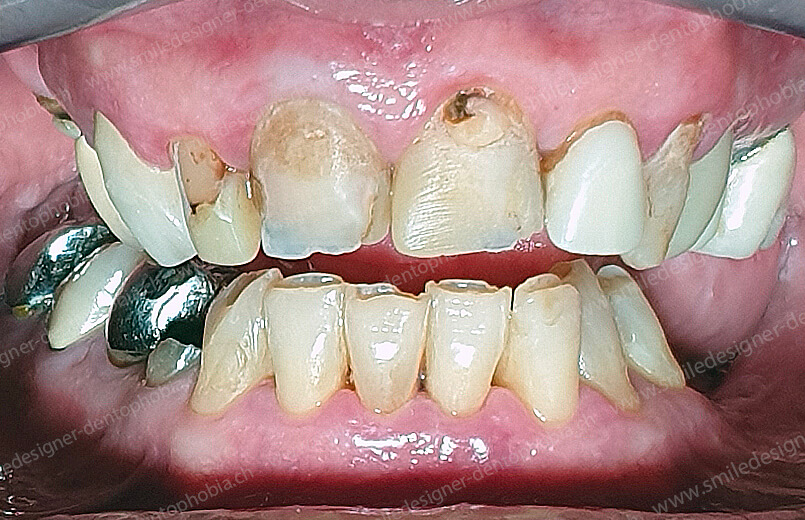
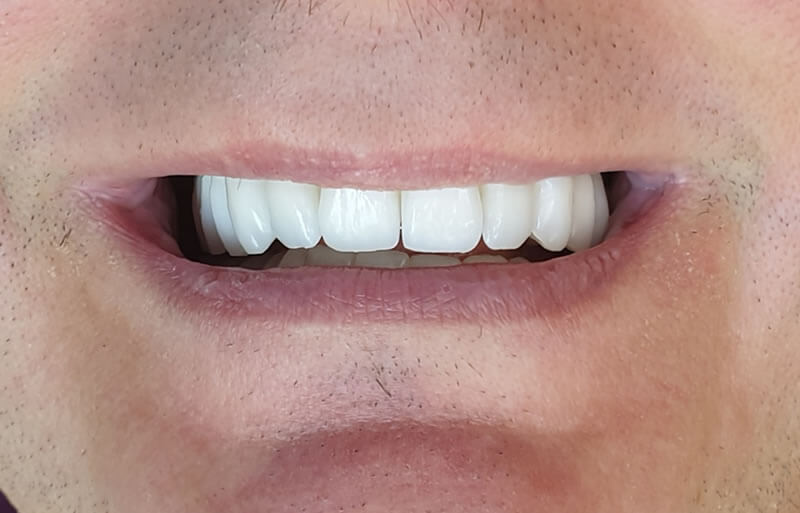


Our clinical result: you have your brand new smile in one implant placement procedure with the delivery of your implant-supported bridges in just a few days.
Domino Surgeries: Our protocol for emergency placement of implants from first premolar to first premolar or “All on 6” in the maxilla and “All on 6/4” in the mandible and the realization of two implant-supported full bridges in a minimal salvage version from first premolar to first premolar, with extensions to replace the first and/or second premolars
Disclaimer: Even though we show satisfactory clinical results in our presentation photos, they can in no way be promises of similar success in your own clinical situation. Each person is different and each clinical case is unique.
SMILE DESIGNER & DENTOPHOBIA PRESENTS ITS MCI PROTOCOL FOR RESCUE
OF DESPERATE CASES AND THE RECONSTRUCTION OF BONE BASES:
THE "DOMINO SURGERIES MCI
WHAT ARE THE MAIN INGREDIENTS OF THE "DOMINO SURGERIES MCI" IMPLANTATION PROTOCOL?
This is the recipe for our “Domino Surgeries MCI” protocol: The rescue solution to make possible a total rehabilitation of your smile, deemed unimplantable due to lack of bone volume to receive dental implants.
- THE PLACEMENT OF A MAXIMUM OF 6 DENTAL IMPLANTS PER ARCH, TO REPLACE THE TEETH OF THE SMILE, IN EMERGENCY RESCUE AND PENDING A DEFINITIVE GLOBAL RECONSTRUCTION.
- BONE GRAFTS FOR SINUS FILLING OR SINUS LIFT IN THE UPPER JAW.
- 3D VERTICAL AUGMENTATION BONE GRAFTS IN THE MANDIBLE.
- THE PROVISION OF A COLLAGENOUS FRAMEWORK THANKS TO ALLOGENIC AND XENOGENIC APPOSITIONAL BONE GRAFTS.
- CONTRIBUTION OF TISSUE GROWTH FACTORS CONTAINED IN PRF.
- PLACEMENT OF IMPLANTS AND BONE GRAFTS PERFORMED IN ONE OPERATION UNDER SEDATION.
Once the bone volumes have been reconstituted using the operating protocols contained in the “Domino Surgeries MCI”, the implants can be placed according to our “Gold Standard MCI” or “Gold Damage Control MCI” protocols.
The film of the most important operation in the jaw:
the "sinus lift
The "domino surgeries mci
Sinus lift and phlebotomy to enrich the allogeneic graft with tissue growth factors.
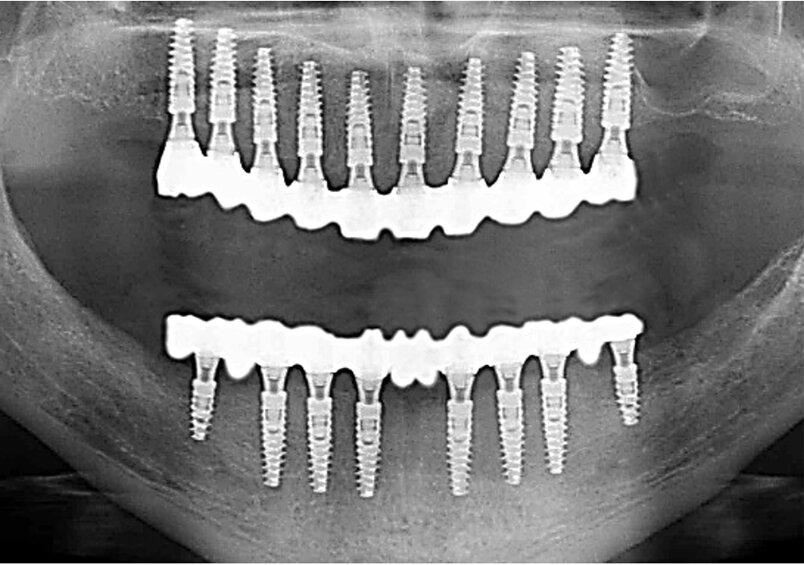
"Domino surgeries mci": the sinus lift in the maxilla to remove contraindications to the placement of molar implants
This intra-sinus bone graft consists of raising the level of the sinus floor from a few millimeters to about fifteen millimeters.
This elevation of the sinus floor is obtained by partially filling the bottom of the sinus cavity. A bone graft is inserted between the inferior cortical bone of the sinus (basal) above the basal bone of the maxilla and the mucous membrane that lines the inner wall of this same cortical bone. This mucous membrane covers all the partitions of the sinus and forms the “Schneider’s membrane”. It is as fragile as “wet toilet paper”. It is therefore very difficult to raise it without perforating it. The perforation of this membrane is the main hazard of this procedure. However, this is the main phase of the sinus lift procedure.
There are two approaches to access the maxillary sinus:
- The crestal route on the top of the alveolar bone ridge. This technique described by Dr. Summers and which bears his name is reserved for simple cases of bone augmentation.
- The lateral approach through an opening in the bony septum of the sinus at the foot of the zygomatic bone (malar or cheekbone) was described by Drs. Caldwell and Luc and bears their names. It is most commonly indicated for large-scale bone grafts. It is preferable to perform this type of intrasinus bone graft in a dedicated surgical space, or better yet, a surgical operating room in a clinic.
To learn more click HERE to be redirected to the sinus lift chapter
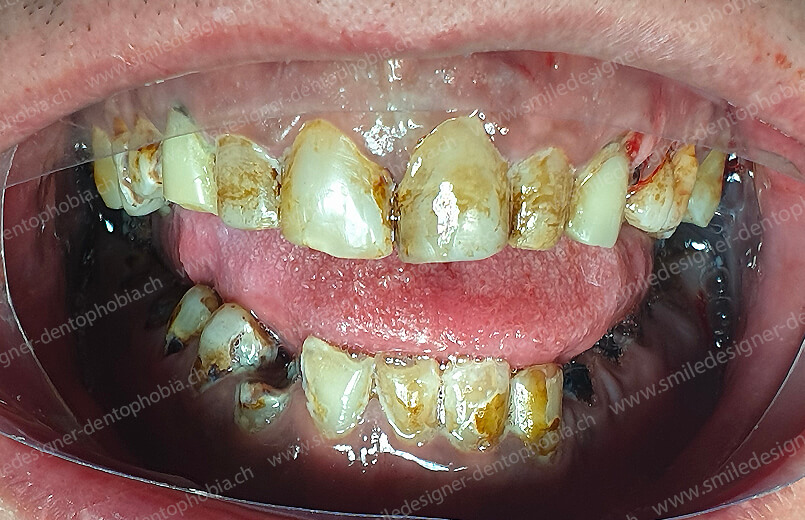
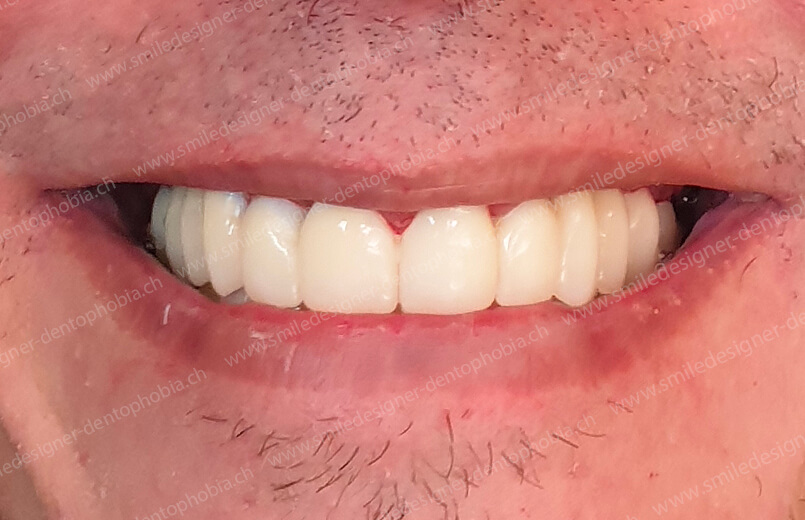
Our clinical result: you have your brand new smile in one implant placement procedure with the delivery of your implant-supported bridges in just a few days.
Domino Surgeries: Our protocol for emergency placement of implants from first premolar to first premolar or “All on 6” in the maxilla and “All on 6/4” in the mandible and the realization of two implant-supported full bridges in a minimal salvage version from first premolar to first premolar, with extensions to replace the first and/or second premolars
Disclaimer: Even though we show satisfactory clinical results in our presentation photos, they can in no way be promises of similar success in your own clinical situation. Each person is different and each clinical case is unique.
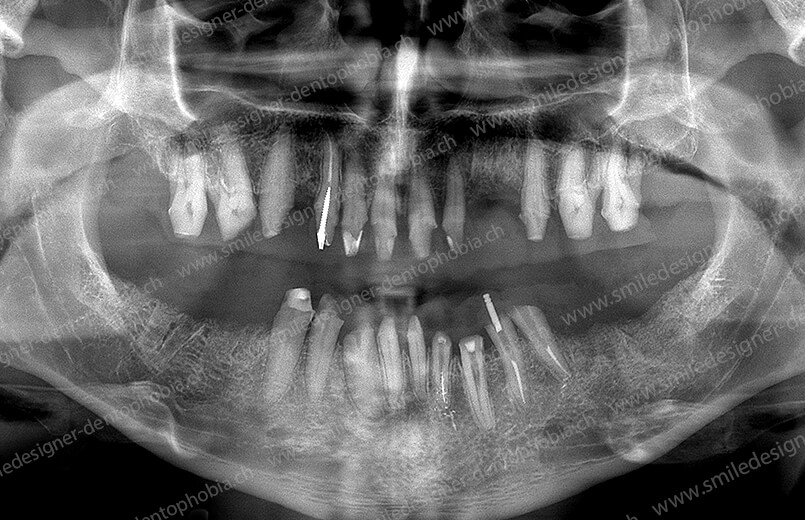
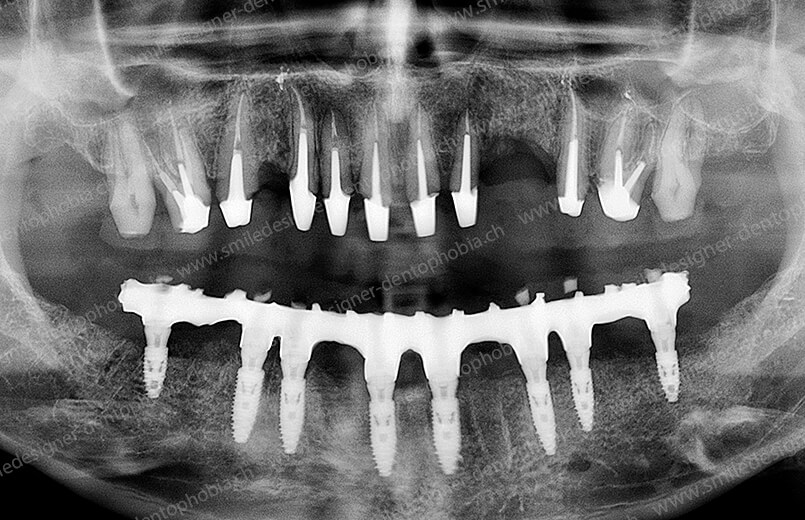
Our clinical result: you have your brand new smile in one implant placement procedure with the delivery of your implant-supported bridges in just a few days.
Domino Surgeries: Our protocol for emergency placement of implants from first premolar to first premolar or “All on 6” in the maxilla and “All on 6/4” in the mandible and the realization of two implant-supported full bridges in a minimal salvage version from first premolar to first premolar, with extensions to replace the first and/or second premolars
Disclaimer: Even though we show satisfactory clinical results in our presentation photos, they can in no way be promises of similar success in your own clinical situation. Each person is different and each clinical case is unique.
Pre-implant bone grafting for mandibular or maxillary vertical augmentation in MCI.
In the upper jaw:
Following vertical resorption of the posterior alveolar bone of the upper jaw, the bone graft to compensate for the lack of alveolar bone height is the sinus filling technique or sinus lift (sinus floor elevation).
This protocol is indicated in cases of high bone insufficiency in the posterior areas of the maxilla below the sinus.
The air cavity formed by the sinus increases in volume, by a phenomenon of pneumatization, when one or more molars are extracted and sometimes the premolars. The sinus is gaining space at the expense of the alveolar bone available to place implants, following the loss of these teeth. The lower part of the sinus cavity volume must be filled with a bone graft to restore the implant alveolar bone volume.
This protocol is chosen when the residual height below the sinus does not exceed 6 millimeters.
In some cases of large vertical resorption, the sinus lift technique can be associated with the technique of apposition grafting with a screw matrix or ROG (guided bone regeneration).
In the lower jaw:
Following vertical resorption of the posterior alveolar bone of the lower jaw, the bone grafting technique used to compensate for the lack of height of the implant-bearing alveolar bone is the apposition grafting technique with a screw-retained matrix or ROG (guided bone regeneration).
A metal matrix defines the bone volume that will be reconstructed. This delimitation of the bone volume to be regenerated is achieved either by osteosynthesis screws or by a titanium grid fixed by these same screws.
This metal dome relieves the bone graft from the pressure of the overlying soft tissues in order to limit the resorption of the graft, induced by this pressure during healing.
This protocol is indicated in cases of high bone insufficiency in the posterior areas of the lower jaw.
This protocol is chosen when the residual height above the inferior alveolar nerve does not exceed 6 millimeters.
To learn more, click HERE to be redirected to the chapter on pre-implant grafts.



